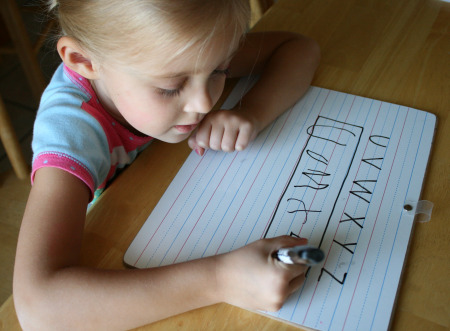Another resource I received from Brookes Publishing (thank you!) is called "Ladders to Literacy." This book is jammed packed with activities; however, it is not as ready to go as Road to the Code . (Don't forget, my readers get a 20% discount by using this code on their website: KA1102 until August 15th). But, because it doesn’t have all the printables in the appendix, there’s more room for activities. I wouldn’t recommend this for parents, because it is definitely geared towards teachers. Yet, I found some activities that you can do right at home:
Call attention to words on books that indicate the title, author and illustrator. Isn't that a good title? It's the first one I could find with an author and illustrator, I promise!

Have your child flip the book around to begin reading. Then have him/her turn the pages to learn concept of print.

Write your child a note on a larger sheet of construction paper. This teaches your child that print is a tool to communicate. Point to the words as you read them. Can your child identify any letters, sounds or words?

Have your child keep a journal. Now, don’t fret about spelling words correctly, or even making letters at all depending on your child’s stage of development. Imaginative letters and inventive spelling is a great stepping stool towards literacy. Do make sure that the “imaginative letters” or “inventive spellings” go in the right direction. And hold your child accountable for letters or words you have discussed. Also, have them illustrate writing to make it easier for you to help identify what is being said! Make sure you get a fun, but small journal. Large ones can be daunting!

Use meal time as a learning opportunity. On index cards, write what your child is eating. After your child finishes, have him/her illustrate the food on the index card. Keep the cards around so that your child is repeatedly exposed to these words. Maybe he/she will even be able to identify items on menus after some practice!
Use nursery rhymes to help your child become more aware of the sounds in words. Have your child memorize one of his/her favorite rhymes. Then, have him/her draw pictures on index cards of the rhyming words. Make him/her scramble the picture cards and place them in order as he/she recites it. If that’s too easy, write the rhyming words on the back of the index cards and see if your child can arrange those!

Teach your child to listen for words through songs. Your child must mimic the actions of the words said in the song. This book suggests using some songs by Red Grammer- “Can You Sound Just Like Me,” “Finger Play” and “Ready Set.” You can easily use simple songs such as “The Hokey Pokey” or “If You’re Happy and You Know It.”
Have any musical instruments in your home? Play them for your child. Can your child discriminate between high and low sounds? Loud and soft?
Practice syllables through art. Have your child draw pictures of multisyllabic words (candy, elephant, etc.). Then, have him/her cut the pictures into however many syllable are in the word. For example, PENCIL would be cut into 2 sections and CALENDAR into 3. As you say the words aloud, model putting the pieces back together, making sure to enunciate the syllables. When all the pieces are put back in place, it completes the puzzle, just like when all the syllables are put into place, it completes the word!
I could keep going on… and on… and on! I’ll stop there to note that the book does include a Parent/Family Guide to Early Literacy Activities. This section is perfect for the busy parent! Here are a few examples:

When you have no hands free- sing nursery rhymes, ask for rhyming words or break a word into phonemes and have your child say it back fast (example: MAR… long pause… KER, and your child says MARKER)
When you’re sitting down- write messages to each other, or describe objects using adjectives

When your child’s friends are around- use magnetic letters in play, measure food for a recipe, scribble together or write secret messages
On rainy days- make books, read books in silly voices, act out books

At the store- have your child go on a letter hunt, searching for letters printed, or even words printed on signs, labels or tags
Bedtime- read aloud and model what fluent reading sounds like
PHEW. Great resource for teachers and parents who are willing to take a little more time to plan for activities and apply group activities to individuals (which is very easily done)!


No comments:
Post a Comment